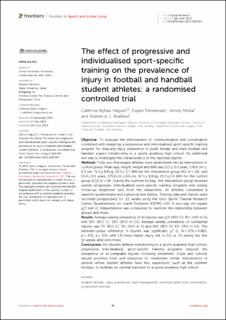| dc.contributor.author | Nyhus Hagum, Cathrine | |
| dc.contributor.author | Tønnessen, Espen | |
| dc.contributor.author | Hisdal, Jonny | |
| dc.contributor.author | Shalfawi, Shaher A. I. | |
| dc.date.accessioned | 2023-06-16T11:55:23Z | |
| dc.date.available | 2023-06-16T11:55:23Z | |
| dc.date.created | 2023-06-06T10:08:39Z | |
| dc.date.issued | 2023 | |
| dc.identifier.citation | Nyhus Hagum, C., Tønnessen, E., Hisdal, J., & Shalfawi, S. A. The effect of progressive and individualised sport-specific training on the prevalence of injury in football and handball student athletes: a randomised controlled trial. Frontiers in Sports and Active Living, 5, 194. | en_US |
| dc.identifier.issn | 2624-9367 | |
| dc.identifier.uri | https://hdl.handle.net/11250/3071812 | |
| dc.description.abstract | Objective: To evaluate the effectiveness of communication and coordination combined with designing a progressive and individualised sport-specific training program for reducing injury prevalence in youth female and male football and handball players transitioning to a sports academy high school. An additional aim was to investigate the characteristics of the reported injuries.
Methods: Forty-two Norwegian athletes were randomised into an intervention or control group. Mean age, height, weight and BMI was 15.5 ± 0.5 years, 178.6 cm ± 6.3 cm, 71.3 ± 9.8 kg, 22.3 ± 2.7 BMI for the intervention group (IG) (n = 23), and 15.4 ± 0.5 years, 175.6 cm ± 6.6 cm, 67.1 ± 9.8 kg, 21.7 ± 2.4 BMI for the control group (CG) (n = 19). During the summer holiday, the intervention group received weekly progressive, individualised sport-specific training programs and weekly follow-up telephone calls from the researchers. All athletes completed a baseline questionnaire and a physical test battery. Training data and injuries were recorded prospectively for 22 weeks using the Oslo Sports Trauma Research Center Questionnaire on Health Problems (OSTRC-H2). A two-way chi-square (χ2) test of independence was conducted to examine the relationship between groups and injury.
Results: Average weekly prevalence of all injuries was 11% (95% CI: 8%–14%) in IG and 19% (95% CI: 13%–26%) in CG. Average weekly prevalence of substantial injuries was 7% (95% CI: 3%–10%) in IG and 10% (95% CI: 6%–13%) in CG. The between-group difference in injuries was significant: χ2 (1, N = 375) = 4.865, p = .031, φ = .114, with 1.8 times higher injury risk in CG vs. IG during the first 12 weeks after enrolment.
Conclusions: For student athletes transitioning to a sports academy high school, progressive individualised, sport-specific training programs reduced the prevalence of all-complaint injuries following enrolment. Clubs and schools should prioritise time and resources to implement similar interventions in periods where student athletes have less supervision, such as the summer holidays, to facilitate an optimal transition to a sports academy high school. | en_US |
| dc.language.iso | eng | en_US |
| dc.publisher | Frontiers Media S.A. | en_US |
| dc.rights | Navngivelse 4.0 Internasjonal | * |
| dc.rights.uri | http://creativecommons.org/licenses/by/4.0/deed.no | * |
| dc.title | The effect of progressive and individualised sport-specific training on the prevalence of injury in football and handball student athletes: a randomised controlled trial | en_US |
| dc.type | Peer reviewed | en_US |
| dc.type | Journal article | en_US |
| dc.description.version | publishedVersion | en_US |
| dc.rights.holder | The authors | en_US |
| dc.subject.nsi | VDP::Medisinske Fag: 700 | en_US |
| dc.subject.nsi | VDP::Samfunnsvitenskap: 200::Samfunnsvitenskapelige idrettsfag: 330 | en_US |
| dc.source.pagenumber | 1-11 | en_US |
| dc.source.volume | 5 | en_US |
| dc.source.journal | Frontiers in Sports and Active Living | en_US |
| dc.identifier.doi | 10.3389/fspor.2023.1106404 | |
| dc.identifier.cristin | 2152125 | |
| cristin.ispublished | true | |
| cristin.fulltext | original | |
| cristin.qualitycode | 1 | |

